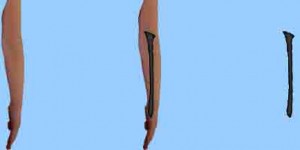The first 3 of the 6 primary strokes are represented using the right arm and hand. The first stroke is the vertical stroke, called 豎 (shù) in Chinese.
Elsewhere, I describe that the base position of the body and arms in order to prepare for arm symbolism is standing straight, with the arms hanging downward, with the hands open and resting alongside the legs. There are 4 joints of the arms that can be used to shift the arm for use in symbolism; the shoulder, the elbow, the forearm, and the wrist.
To form the vertical stroke, 0 shifts in arm position are required. The initial position represents the first stroke. To represent the vertical stroke, leave the right arm extending vertically downward. The upper arm, the lower arm, and the hand extend along a single straight line, with the hand open and the palm facing inward against the leg.
In the drawing of this stroke, Rule 1 applies: Strokes are drawn from top to bottom. Rule 2 does not apply, since there is no horizontal in this stroke. For all strokes that honor both rules, such as this stroke, the right arm is used to represent the stroke.
Where there is a vertical stroke, it often defines the midline of the character or the character section. Except for the horizontal stroke, the other primary strokes do not touch the midline, but only move toward it or away from it.
There is a shortened variation of this stroke. The elbow can be bent, rotating the forearm forward, such that it is no longer visible.
The following is an example of a part of a character that uses both the long and short forms of the vertical stroke. The long form has a hook stroke at the bottom, which will be discussed next.
If we consider each stroke separately, instead of recognizing the combinations involved, the character that means eternal (yǒng) can be considered to contain each of the first 7 strokes that we will cover. The shù stroke is the vertical stroke that forms the midline of the character.


